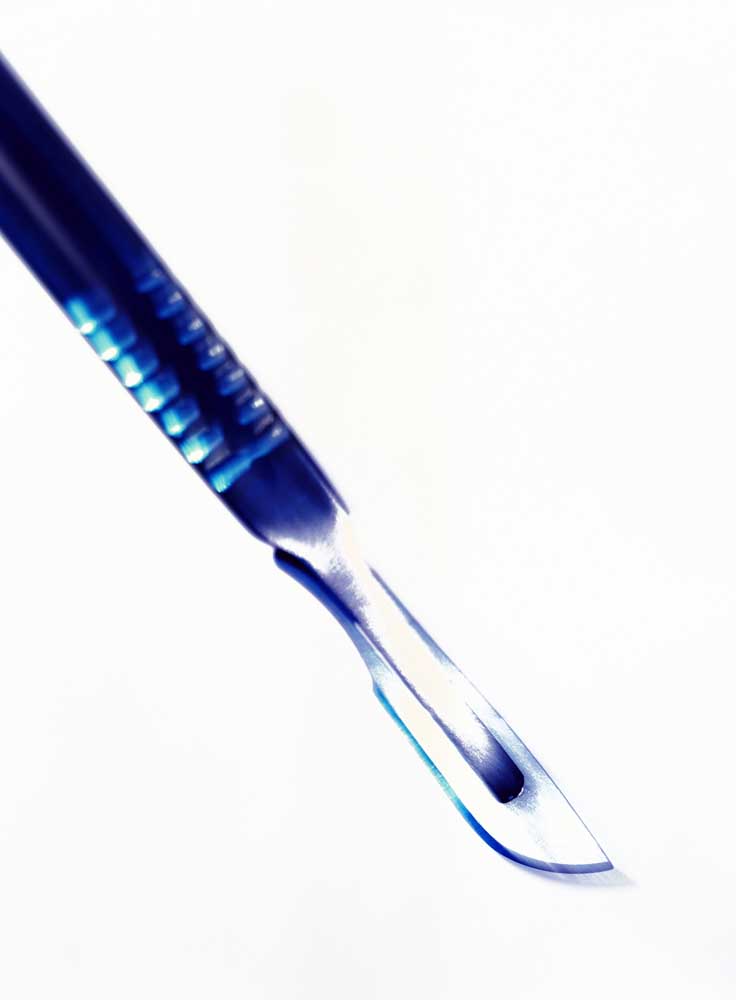Virtual dissection table offers real lessons in anatomy
Published 6:55 am Friday, February 23, 2018

- This stock photo shows a clean scalpel.
When Oregon State University converted its Cascades campus in Bend to a four-year university, the science department faced a dead-body problem. To properly teach three levels of anatomy and physiology courses to students working toward a health career, they needed human cadavers. But cadavers are expensive — running about $20,000 a body — and require rooms fitted with costly ventilation systems. School officials had considered placing a mobile home on the campus — a option they dubbed “the dead shed” — but concerns over the security of a freestanding building containing human cadavers nixed that approach.
The school ultimately decided to purchase an Anatomage table, a computerized touch-screen large enough to show a lifesize human body, that allows students and faculty to dissect a virtual cadaver with just a swipe of a finger.
“We try to be very innovative in how we think about our programs and how we think about delivering our content to our students,” said Kara Witzke, assistant dean and kinesiology program lead at OSU-Cascades. “We want them to be trained using the latest tools in the industry, and it seemed like a good opportunity to explore a technology solution to a space and cost problem.”
As technology solutions get better and more affordable, while access to cadavers becomes tighter and more expensive, many educational facilities are weighing the trade-offs of adopting virtual dissection for teaching the basics of anatomy. Such tools are sparking a fierce debate in the educational world about whether technological solutions can adequately replace the experience of working with real bodies.
The debate highlights the advantages and disadvantages of cadaver studies. Cadavers give students a better idea of the three-dimensional structures of the body. But preserved tissue doesn’t bear much resemblance to a live body after it starts drying out. And once a portion of the cadaver has been dissected, it cannot be restored.
“We lose the ability to see a lot of the muscles, a lot of the structures get damaged during dissection,” said Heather Broughton, anatomy and physiology instructor at OSU-Cascades.
“They get damaged over the course of the term from students pulling on them.”
Broughton, who taught anatomy on the main OSU campus in Corvallis before coming to Bend, initially had her reservations about the Anatomage table.
“I was worried about how involved and how into this the students would be,” she said. “But what I found is they’re very engaged and they like to be able to dissect them themselves.”
Typically students in dissection courses work in teams to dissect a body, and in lower-level anatomy and physiology course, don’t do any dissecting at all. At the main campus, OSU anatomy and physiology students learn on cadavers dissected by students in the dissection class. Students must complete three terms of anatomy and physiology, and get an A in each class, to be admitted into the dissection class. As a result, few undergraduate students ever cut into a body.
But with the table, Broughton and her students can cut and restore the various parts of anatomy at will.
“I’ve actually been really impressed with the table, and I use it as a teaching tool,” she says. “I think for a first time, at least in an anatomy and physiology course for undergrads, it actually makes a lot of sense in that regard, because it shows them the principles of where everything is. And then hopefully, with future dissection courses, they can go back and actually have hand on the structure.”
Virtual solutions like the table are second nature to today’s college students, who grew up tapping and swiping phones or tablets. Unlike with real cadavers, students can work on the table independently without concerns someone might take a photo or so something inappropriate without supervision.
“They’re really in tune with using that sort of technology anyway,” Broughton said. “It’s very user friendly. Once you’ve had a run through, it’s not hard to use the table.”
The OSU students refer to the virtual cadaver as Table Tim. They have lifesize and desktop skeletons that are marketed as Big Tim and Little Tim, so the name stuck.
For a class in December, Broughton had placed virtual pins on Table Tim and asked students to identify the different muscles she had marked.
“The student can for all intents and purposes actually dissect them. You can reconstruct them,” she said. “You can take something off a muscle and then you can add it back on. It’s not a permanent disfigurement.”
Growing market
Anatomage company officials declined to provide a current count of the number of schools using its table, but Director of Sales Tommy Le said the number was in the hundreds in the U.S. and a hundred more internationally. Most schools are using the table to augment their cadaver labs, but a few schools have switched completely to virtual dissection.
“There are institutions where cadaver access is very limited, so this is a good alternative,” he said. “Especially at the community college level where they don’t have the budget or they don’t have the facility.”
In March, the Long Beach Unified School District in California became the first in the nation to purchase the table for its high school health and medical pathway program.
An Anatomage table costs about $72,000, and comes preloaded with three full human cadavers, with a fourth coming sometime in early 2018. The images come from people who have donated their bodies for this purpose. Their bodies are frozen immediately after death and then imaged with no embalming.
Le said while there are a number of virtual dissection products, he believes Anatomage provides the most realistic view of human anatomy. All of the images provided with the table are from actual human bodies, not 3-D simulations or computer-generated models.
“What you see on there is the true color of the anatomy,” Le said. “As opposed to after the embalming process, they turn mostly grayish, brownish depending on the process.”
The table also comes with a variety of clinical cases so students can see what a gunshot wound looks like or an ectopic pregnancy. The table also allows programs to upload medical imaging, including CT scans, MRIs and x-rays, and can recreate virtual bodies from those scans. Some schools, Le said, will take CT scans of all their cadavers, so that if they come across an interesting clinical case, more students can learn from that single donation.
And the table can allow students to do things that would be hard if not impossible to do with a real body. A reset button allows them to restore all of the changes they’ve made and start over. And they can easily manipulate the image to see the body from any angle.
“It’s very difficult to rotate a physical cadaver,” Le said. “They’re heavy, you’ve already cut into them, so you have issues rotating them.”
Emerging technology
Anatomage is one of many companies offering such digital solutions. One of the first virtual dissection tools was the National Library of Medicine’s Visible Human Project completed in 1994, in which a male death row inmate donated his body. The cadaver was frozen and sliced to 1 millimeter cross sections, then photographed and digitized. Digitization of a female cadaver with slices just a third of millimeter was completed a year later.
Other companies are developing virtual reality simulations where students use headsets and view a three-dimensional room with a virtual cadaver on a dissection table.
“It’s not just the simulation — it’s how do you immerse people in it, so that they feel like they’re almost living it as much as they would be interacting with either cadaveric material or a living person,” Mark Hankin, senior anatomist at Oregon Health & Science University.
Hankin, who helped develop McGraw-Hill Education’s widely used virtual dissection tool called Anatomy & Physiology Revealed, said it’s important to distinguish between virtual dissection programs that use images of actual cadavers versus those that simulate dissection with computer-generated graphics.
“It’s a different experience than looking at something that’s more cartoonish, which has been constructed, but it doesn’t look real,” he said. “It may have great fidelity, but you still know it’s not real.”
It’s also unclear how well students will learn anatomy and physiology with virtual solutions rather than real cadavers. Just a few studies have tried to measure the comparative effectiveness in any rigorous way, and results have been mixed. Researchers at the Iowa State University found that students did better at learning the material when 3-D tools were used in conjunction with lecture and cadaver dissection. A Michigan State University study found students who learned on a cadaver score higher than students learning solely on a virtual table when tested on a cadaver.
Dissecting cadavers also helps introduce students to basic surgical techniques and approaches. While some schools use cheap copies of surgical tools, OHSU uses a full surgical kit, with surgical grade tools to help students learn the tool names and how they function. Students generally work in teams to dissect a cadaver, helping them learn teamwork and problem solving strategies.
But working with cadavers is much more than just a lesson in anatomy for medical students. Aspiring doctors often refer to their cadaver as their first patient and often name their cadaver to begin to think of him or her as a human being, rather than a prop.
“There are the more esoteric aspects of working with a dead person, understanding how that makes you feel, to develop as a health professional an appreciation for death and dying,” Hankin said.
For many, working with a cadaver is a lesson in humanity and compassion. Many schools hold a memorial service at the start of the school year as the previous year’s cadavers are sent to their final resting place.
Those experiences may be more important for medical students who will soon have to treat real patients, than undergraduates who may not pursue a patient care career. Augmenting virtual dissection with access to cadaver studies could offer the best of both worlds.
OSU-Cascades has had discussions about partnering with Central Oregon Community College, one of the few community colleges that has access to a real human cadaver. COCC acquires a new cadaver each year from Western University of Health Sciences in Lebanon, and pays graduate students to dissect the cadaver before it is shipped to the Bend campus. The cadaver can be used mainly for anatomy and physiology courses but it is available to other classes as well.
Amanda Layton, assistant professor of human biology and the cadaver coordinator at COCC, said there is no substitute for work with an actual human body.
“I tell students constantly to feel the artery versus the vein versus the nerve,” said Amanda Layton, assistant professor of human biology and the cadaver coordinator at COCC. “Just looking at it, it’s very difficult for an untrained eye to be able to tell which is which.”
A partnership between the two schools would allow students who complete anatomy and physiology courses in the fall, winter and spring terms to take a cadaver dissection class during the summer. That cadaver would then be available for the next year’s incoming anatomy and physiology students. That would save COCC money on dissection costs and give OSU-Cascades students a chance to try dissection. •
(Editor’s note: This story has been corrected. Kara Witzke’s title and the location of Western University of Health Sciences were incorrect in the original version. The Bulletin regrets the error.)
“It’s a different experience than looking at something that’s more cartoonish, which has been constructed, but it doesn’t look real. It may have great fidelity, but you still know it’s not real.”— Mark Hankin, senior anatomist at Oregon Health & Science University






